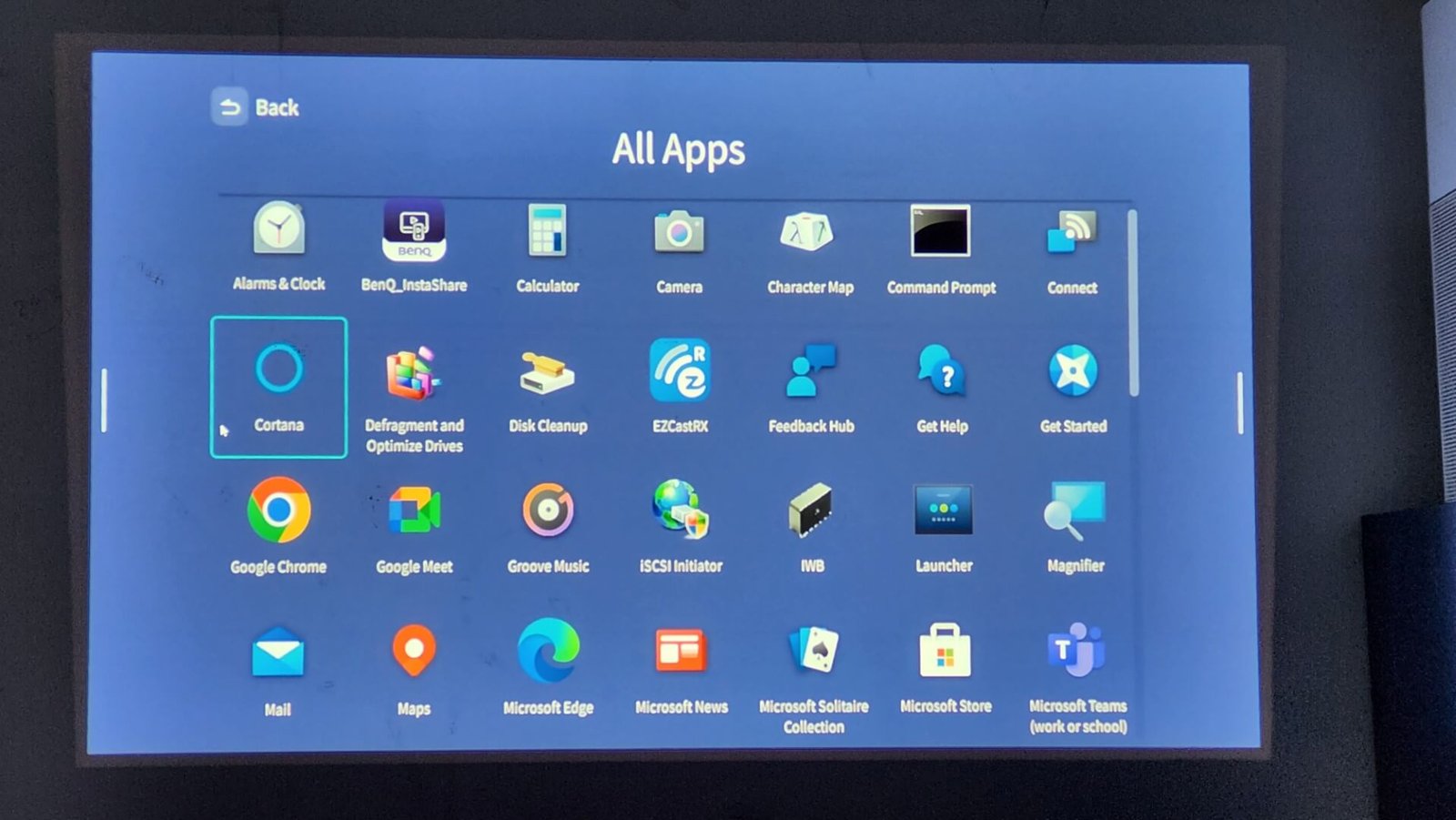While most projectors require users to go through the hassle of connecting to external devices during a meeting, BenQ’s latest smart projector solves and simplifies with their latest Windows-powered smart projector. We review the BenQ EH620 Smart Projector with Windows OS built-in.
The BenQ EH620 is designed as an all-in-one projector for reducing the management of connecting multiple devices during a meeting. The device comes with dimensions of 380 x 127 x 263mm and weighs about 4.2kg. Just as most other BenQ projectors, the EH620 features an all-white chassis with air vents on either side.
 The projector comes with numerous connectivity options on the rear side and includes one D-Sub PC in port, one D-Sub PC out port, one RS232 DB-9pin port, two HDMI 1.4a/HDCP1.4 ports, three USB 3.0 Type-A 3.0 ports, two USB 2.0 Type-A ports, and one USB Type Mini B port. All of the USB Type-A ports have support for power supply up to 1.5A. The external control panel is located on the top-left side of the device and the buttons include the power button, back, menu, source selector, directional and OK buttons.
The projector comes with numerous connectivity options on the rear side and includes one D-Sub PC in port, one D-Sub PC out port, one RS232 DB-9pin port, two HDMI 1.4a/HDCP1.4 ports, three USB 3.0 Type-A 3.0 ports, two USB 2.0 Type-A ports, and one USB Type Mini B port. All of the USB Type-A ports have support for power supply up to 1.5A. The external control panel is located on the top-left side of the device and the buttons include the power button, back, menu, source selector, directional and OK buttons.
 And above the control panel buttons are the zoom and focus rings colored in black. There is also a shutter that covers the zoom/focus rings and this can protect it from dust particles when not in use. There are also adjustable feet on the bottom, along with holes for wall-mounting capabilities.
And above the control panel buttons are the zoom and focus rings colored in black. There is also a shutter that covers the zoom/focus rings and this can protect it from dust particles when not in use. There are also adjustable feet on the bottom, along with holes for wall-mounting capabilities.
 The projector comes with a multi-functional remote that has shortcuts to several functions such as opening HDMI selector, switching to PC mode, settings, mouse, volume rockers, WiFi, back, visual controls, home button, and more.
The projector comes with a multi-functional remote that has shortcuts to several functions such as opening HDMI selector, switching to PC mode, settings, mouse, volume rockers, WiFi, back, visual controls, home button, and more.
The rear side of the projector also features dual 5W speakers that are tuned for video conferences. The packaging of the device includes the EH620 projector, power cord, VGA cable, USB WiFi dongle, remote, a quick start guide, and warranty card. While the native resolution of the display is 1080p, the maximum brightness is 3400 ANSI lumens and the contrast ratio is 15,000:1. The device is capable of producing 30-bit (1.07 billion colors) projection. The main lamp features a life of 4000 hrs in normal mode, 10000 hrs for ECO mode, and 15000 hrs for SmartEco mode.
 The projector also comes with a throw ratio that ranges between 1.13~1.47, zoom capabilities up to 1.3x, and 1D keystone adjustment with ± 40 degrees. The auto keystone mode will automatically correct the projection angle during a normal projection or when you launch a projection file. BenQ mentions that the projector is also capable of casting content from multiple devices simultaneously in a 4-split window mode. You can also share content with the projector from multiple devices simultaneously.
The projector also comes with a throw ratio that ranges between 1.13~1.47, zoom capabilities up to 1.3x, and 1D keystone adjustment with ± 40 degrees. The auto keystone mode will automatically correct the projection angle during a normal projection or when you launch a projection file. BenQ mentions that the projector is also capable of casting content from multiple devices simultaneously in a 4-split window mode. You can also share content with the projector from multiple devices simultaneously.
 While the device comes with Windows 11 OS, the chipset that powers the device is just mediocre in terms of performance. The processor used here is the Intel Celeron 4205U, a low-end 4GB RAM, and a Kingston TX2964 SSD with Windows 11 IoT Enterprise edition installed. To be honest, the performance was a bit sluggish, and it’s mostly due to the fact that BenQ is trying to run the latest Windows 11 on a very old entry-level processor with limited memory and a slow SSD.
While the device comes with Windows 11 OS, the chipset that powers the device is just mediocre in terms of performance. The processor used here is the Intel Celeron 4205U, a low-end 4GB RAM, and a Kingston TX2964 SSD with Windows 11 IoT Enterprise edition installed. To be honest, the performance was a bit sluggish, and it’s mostly due to the fact that BenQ is trying to run the latest Windows 11 on a very old entry-level processor with limited memory and a slow SSD.
While we understand BenQ may have decided to use low-end hardware to keep the costs down, the brand could have chosen a slightly better specification, such as any of the mid-range 10th or 11th-generation Intel processors, 8GB of RAM at the minimum, and a 512B NVMe SSD (PCIe 3.0 or SATA). After all, the whole purpose of having Windows on this device is to eliminate the need to connect multiple devices. And the experience may not be worth it if the performance of the machine is sluggish.
That said, BenQ mentions that the projector comes with enterprise-grade security and this includes the Celeron 4205U chip featuring the Intel Runtime BIOS Resilience. The projector also comes with AES 128-bit security encryption and WPA2 authentication protocol, along with Intel Platform Trust Technology that offers support for BitLocker drive encryption and Microsoft requirements for firmware Trusted Platform Module (fTPM) 2.0.
 BenQ has also included an easy-to-use launcher that assists users to control the projector easily with the remote. The launcher offers shortcuts to open apps easily, access settings, HDMI selector, wireless projection mode, file manager, keystone, and more. This makes sense since it will be difficult to control Windows with the remote and this also eliminates the need to connect a mouse.
BenQ has also included an easy-to-use launcher that assists users to control the projector easily with the remote. The launcher offers shortcuts to open apps easily, access settings, HDMI selector, wireless projection mode, file manager, keystone, and more. This makes sense since it will be difficult to control Windows with the remote and this also eliminates the need to connect a mouse.
Verdict
While we have tried several BenQ projectors in the past that are meant for different categories, the BenQ EH620 is not only unique for its smart capabilities but the fact that it includes its own PC system with Windows 11 built-in. And the purpose of a Windows 11 business projector is to offer a hybrid meeting solution without the need to collect multiple devices such as laptops and speakers and eliminate the need for wired connections. The projector has a decent projection of 3400 lumens with 1080p resolution. Even with its multi-casting capabilities, the projector still offers numerous connectivity options such as D-Sub, HDMI ports, USB-A with power delivery, and more.
 However, the processor and RAM are just okay in terms of performance and we hope BenQ can provide better hardware on the next iteration so users can experience smooth Windows performance. Even though the projector comes with mediocre specifications to run Windows 11 IoT Enterprise edition, the device comes with enterprise-grade security such as Intel Runtime BIOS Resilience, AES 128-bit security encryption, WPA2, Intel PTT, and Trusted Platform Module (fTPM) 2.0. BenQ’s launcher also helps to use the device easier with quick shortcuts to several functions of the EH620 smart projector.
However, the processor and RAM are just okay in terms of performance and we hope BenQ can provide better hardware on the next iteration so users can experience smooth Windows performance. Even though the projector comes with mediocre specifications to run Windows 11 IoT Enterprise edition, the device comes with enterprise-grade security such as Intel Runtime BIOS Resilience, AES 128-bit security encryption, WPA2, Intel PTT, and Trusted Platform Module (fTPM) 2.0. BenQ’s launcher also helps to use the device easier with quick shortcuts to several functions of the EH620 smart projector.






